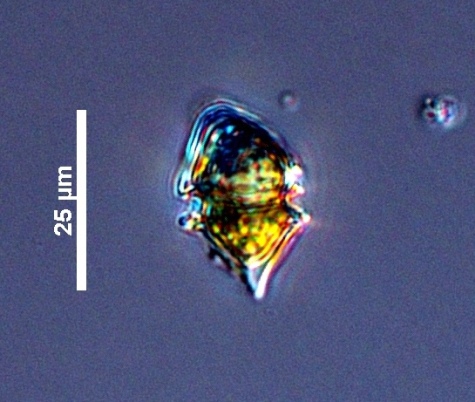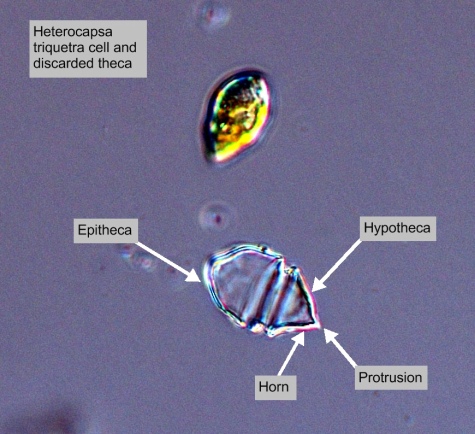



|
Synonym(s)
Properidinium heterocapsa (Stein) Meunier 1919
Peridinium triquetra (Ehrenberg) Lebour 1925
Peridinium triquetrum Schiller 1937
(Guiry and Guiry 2011)
Classification
(Guiry and Guiry 2011)
Lifestyle
Description
Epitheca
In thecate dinoflagellates, the anterior part of a dinokont cell above the cingulum. The equivalent of epicone for naked dinoflagellates.
epitheca is conical with straight sides and a rounded end. The hypotheca has an asymmetrical CloseHorns
The apical or antapical extensions found in some armoured dinoflagellates; they contain cytoplasm, are covered in thecal plates and can be hollow or partially solid (Horner 2002).
horn and a unique protrusion. Cells do not have CloseSpine
In some diatoms, "closed or solid structures projecting from the cell wall;" in dinoflagellates, solid projections that usually taper to a point.
spines. The cells also have a slightly displaced and descending CloseCingulum
(dinoflagellates) "In dinokont dinoflagellates, a furrow encircling the cell one or many times" (Horner 2002). It is also known as the girdle or transverse groove and may be located at, above, or below the midpoint of the cell with the left and right ends meeting or displaced form one another (Horner 2002). In diatoms, this term describes the collective elements of a diatom girdle: "The cingulum is made up of delicate silica bands that join the two valves of a frustule. Most diatoms possess a cingulum, although some may not" (Spaulding et al. 2010).
cingulum. It has numerous golden chloroplast (Horner 2002).Measurements
Width: 9 - 18 μm
(Horner 2002)
Similar species
Harmful effects
Heterotroph/heterotrophic
An organism that cannot convert inorganic carbon into a usable energy source. Instead, it consumes other organisms to obtain organic carbon for growth.
heterotrophic dinoflagellates, ciliates and copepods (Olli 2004). At cell densities above 5000 cells L-1, blooms may cause water CloseDiscolouration
Change of water colour due to an algal bloom.
discoloration to orange-brown (Olli 2004).Habitat
Distribution
Environmental Ranges
Temperature range (°C): -1.813 - 23.128
Nitrate (μmol L-1): 0.584 - 9.364
Salinity: 19.590 - 37.775
Oxygen (mL L-1): 4.981 - 9.002
Phosphate (μmol L-1): 0.051 - 1.129
Close
Silicic acid
A general term to describe chemical compounds containing silicon, oxygen and hydrogen with a general formula of [SiOx(OH)4-2x]n. Diatoms polymerize silicic acid into biogenic silica to form their frustules (Azam and Chisholm 1976).
Silicate (μmol L-1): 0.687 - 29.549Bloom characteristics
Eutrophic/eutrophication
Water that is enriched in natural or artificial mineral and organic matter, which promotes an abundance of plant life (i.e., algae), and can result in reduced oxygen conditions.
eutrophication and local artificial mixing caused by large passenger ferries (Olli 2004). Large July and August blooms have been observed in the Baltic Sea near Finland for these reasons (Lindholm and Nummelin 1999). Often, the bulk of the population lives in the upper surface layer, in light levels above 100 μE m-2 s-1 (Olli 2004).References
Encyclopedia of Life (EOL). Heterocapsa triquetra (Ehrenberg) Stein, 1883. http://www.eol.org/pages/10237. Accessed 26 Aug 2011.
Guiry, M. D. and Guiry, G. M. 2011. Heterocapsa triquetra (Ehrenberg) Stein 1883 http://www.algaebase.org/search/species/detail/?species_id=45678. Accessed 22 Aug 2011.
Guiry, M. D. 2011. Heterocapsa triquetra (Ehrenberg) Stein 1883 http://www.marinespecies.org/aphia.php?p=taxdetails&id=110153. Accessed 21 Oct 2011.
Horner, R. A. 2002. A Taxonomic Guide To Some Common Phytoplankton. Biopress Limited, Dorset Press, Dorchester, UK. 200.
Lindholm, T. and Nummelin, C. 1999. Red tide of the dinoflagellate Heterocapsa triquetra (Dinophyta) in a ferry-mixed coastal inlet. Hydrobiologia. 393: 245-251.
Olli, K. 2004. Temporary Cyst Formation of Heterocapsa triquetra (Dinophyceae) in Natural Populations. Marine Biology. 145: 1-8.
Steidinger, K. A. and Tangen, K. 1997. Dinoflagellates. In: Tomas, C. R. (ed.) Identifying marine Phytoplankton. Academic Press, Inc., San Diego. 531.
